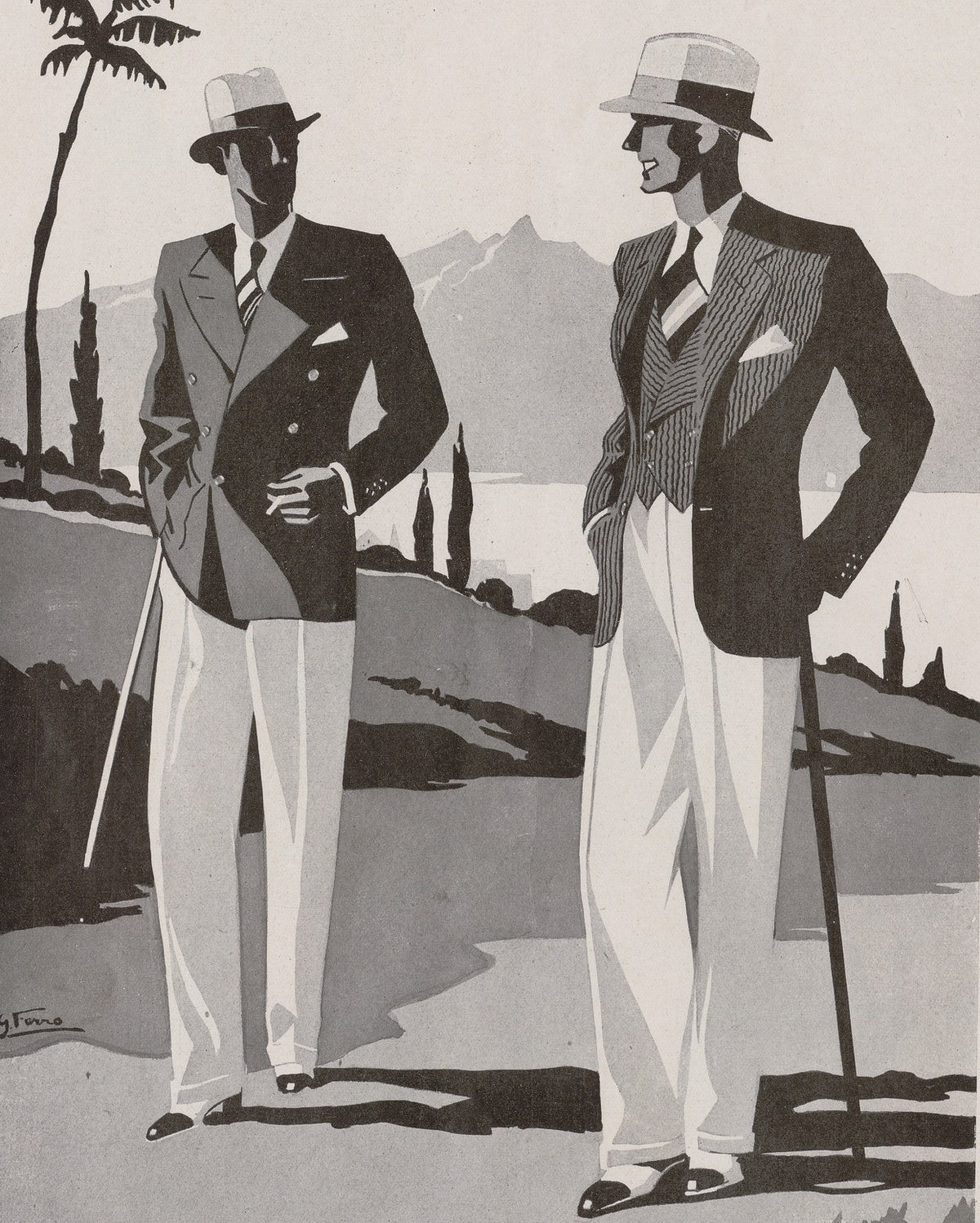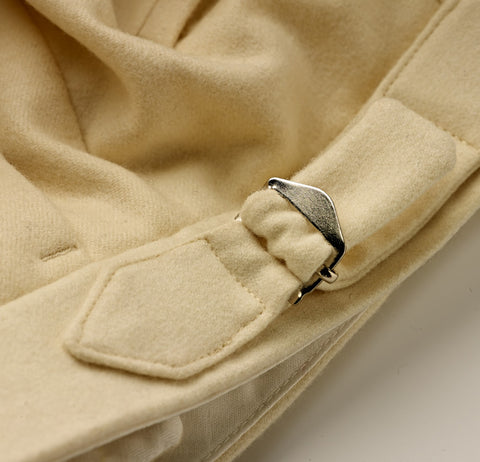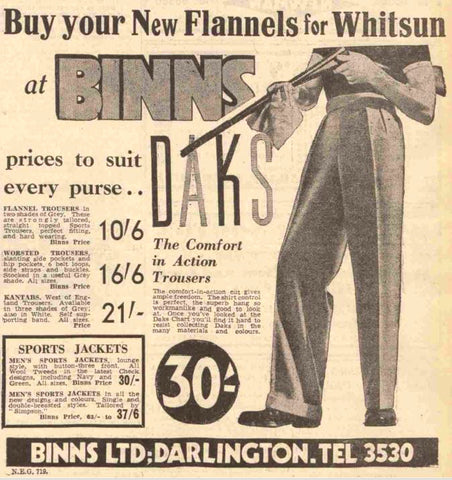Flannel Trousers: A British Classic

By Sean Longden

If there was one outfit that defined British menswear during the mid-20th Century, it was the casual combination of light coloured flannel trousers worn with a contrasting sports jacket. For around thirty years, starting in the mid-1920s and then declining with the arrival of ‘youth fashions’ in the 1950s, this was the look that was worn everywhere: from the promenades and beaches of the seaside resorts, to the terraces of football stadiums and everywhere in between, this fashion crossed the boundaries of age and class. It was a look that was just as popular with the average British working man as it was among Hollywood’s elite, many of whom shopped in the UK.

The combination of light coloured flannels was seen on the pages of French style journals, German tailoring journals and on the backs of men around the globe who took their style tips from the British fashions.

The fashion for wearing contrasting jackets and trousers had its roots in the 19th Century. It had been a regular feature of Victorian menswear and the casual look of light coloured trousers and darker jacket remained a popular summer style in the Edwardian era. It became the sporting look: think cricket ‘whites’ worn with white canvas boots and topped off with a suit jacket, or white trousers worn with a boating blazer. Loose fitting, casual and comfortable, this was the uniform of summer leisure. Sober suiting might have been the respectable choice for office workers, and heavy dark fabrics were favoured by the industrial workforce, but at weekends these were cast aside in favour of comfort.
 Wool flannel was most associated with the town of Huddersfield in West Yorkshire, in an area where the surrounding hills were home to farmers who raised and sheared the sheep to provide the wool for the cloth. The same rainy hills provided high quality soft water that was ideal for the production of high quality wool. In the industrial age, large-scale local mills - which had replaced the old cottage weavers – spun, dyed and weaved the wools, then local cloth merchants sold the finished fabrics to eager clients from around the world. In the menswear trade, Huddersfield flannel was spoken of with the same reverence as Harris Tweeds, it was a distinctive product that was trusted by both the most exclusive tailors and the mass market menswear factories. English flannel was a byword for quality.
Wool flannel was most associated with the town of Huddersfield in West Yorkshire, in an area where the surrounding hills were home to farmers who raised and sheared the sheep to provide the wool for the cloth. The same rainy hills provided high quality soft water that was ideal for the production of high quality wool. In the industrial age, large-scale local mills - which had replaced the old cottage weavers – spun, dyed and weaved the wools, then local cloth merchants sold the finished fabrics to eager clients from around the world. In the menswear trade, Huddersfield flannel was spoken of with the same reverence as Harris Tweeds, it was a distinctive product that was trusted by both the most exclusive tailors and the mass market menswear factories. English flannel was a byword for quality.

It was the ideal cloth for casual clothing. Flannel was smooth enough to look elegant when carefully pressed with a precise crease, yet soft enough to drape well, making it comfortable for an active lifestyle. And flannel was strong and hardwearing, making it an economical choice for the average man. And the perfect colour was grey, which was easily combined with any colour and had the advantage of hiding stains. The fashionable British look was outlined in a 1930’s advertisement extolling the virtues of wearing ‘232’ brand grey flannels with a sports coat: “They’re going everywhere together! The best dressed men are wearing them! Slipping into grey flannels and a sports coat was once a man’s way of showing that his social activities were over for the day. But today, grey flannels and sports coats get out and about. They are known socially … they are in the public eye! The best dressed Englishmen are wearing them on an increasing number of occasions.”

The look began to develop in the early 1920s when there was a quiet revolution in British menswear. Starting among the students at the elite Oxford and Cambridge universities, whose fashions were regularly reported on in the British press, a new casual look evolved. Vivid colours arrived, particularly in knitwear, and the shirt and tie combination was increasingly abandoned in favour of high necked, brightly coloured jumpers. The notion that distinctive youth styles, complete with bright colours and styles that were a challenge to an older generation, only began with the teenage revolution of the 1950s is a myth that can be undermined by reading the numerous press reports that detailed the undergraduate styles and how they spread from the universities to youths around the country. In keeping with this celebration of comfort over formality, trousers began to be cut wider and worn longer. New colours and shades appeared as Oxford undergraduates experimented with pink, mauve and light green flannel cloth. These ‘art shades’, as they were advertised, seemed revolutionary but never quite eclipsed the popularity of grey and cream for summer wear. The other new arrival was fawn, which outlived the fashion for more outlandish colours but could not quite hit the heights that grey was able to scale.


This new style of wide trousers, worn longer than earlier styles to drape over the shoes, established a template for casual trousers for the years ahead. The colour choices initially diminished as the extreme choices available in the mid-1920s were replaced by a core choice of less extravagant colours. Various shades of grey dominated the market, whilst cream or white flannel remained popular for a more sporting look. Some brands offered up to four choices of grey – silver, light, mid and dark – whilst other colours such as biscuit, light green, lovat, nut brown, oatmeal and a range of blue shades were also available. Having become a hit in the UK, the style spread worldwide and captured the imagination of youths and students everywhere.

By the mid-to-late 1930s a wide range of colours were again available with the ‘Daks’ brand offering their trousers in up to eight fabrics and an incredible range of 41 colours. In the pre-war years most brands concentrated on plain flannels although some offered trousers with an overcheck, making them an ideal accompaniment to a plain jacket. In the post-war years striped flannels became available from some brands, such as ‘Guards’, although it was not clear whether this was responding to changes in fashion or simply that, due to cloth shortages, manufacturers offered whatever they had available.
The smaller details of the trousers fluctuated: both angled pockets and pockets on the side seam were available; flapped coin pockets, more commonly associated with suit trousers, were seen; extension waistbands, fastening with a clip, were popular; buckled side-adjusters appeared and narrow belt loops became common - both allowing men to abandon braces – although interior buttons were sometimes still included for those needing additional support.

Even details like a traditional high fishtail-back with brace buttons, combined with belt loops, were seen on some trousers. Some brands came with a detachable self-fabric belt. The ‘Sportown’ brand offered extender tabs for braces, which could be concealed beneath the waistband when not in use, a feature - often referred to as ‘rabbit ears’ - most commonly associated with continental tailoring. There was even a style of flannels, sold under the brand name ‘Clews’, that could be quickly converted into Plus-4s for sporting activities.
At times flannel trousers were available in varying widths, with narrower styles favoured by the more conservative male while wider styles – sometimes up to 26 inches – reappeared to echo the heady days of summer 1925 and were favoured by younger men. In the late 1940s and early 1950s flannel trousers started to get narrower as fashions changed, yet still retained their basic shape. Yet for all these changes and choices, the basic trouser style went all but unchanged: double, forward facing pleats gave the legs freedom to move and permanent turn ups helped give weight to the hems, affording the trousers an elegant drape.


It seemed that all the menswear producers offered a selection of flannel trousers. One shop advertised that it carried a combination of 72 sizes and fittings. The chain of Foster Brothers shops offered a range of six trousers: ‘Fostrian’ was the basic, low cost flannel range, coming in over 50 shades; ‘Xtrastrong’ was hard wearing, but relatively cheap flannel; the ‘Sunshine’ brand had a worsted finish; ‘Crown’ trousers had an extending waistband; the ‘Sceptre’ range offered sloping pockets; and the ‘Royal’ range was the most expensive, in pure worsted or gabardine with sloping pockets and an extending waistband. Foster Brothers also offered the ‘Winit’, ‘Cambridge’ and ‘Stylval’ flannels. Brands like ‘232 Flannels’ were widely advertised, being available through shops around the country. The brand had been launched in 1922 and its successful advertising campaigns meant it was selling 300,000 pairs a year by 1930. Smokers could even get free flannel trousers by collecting coupons from inside packets of ‘Black Cat’ cigarettes.


One of the major changes came in the mid-1930s when self-supporting trousers arrived. The most famous example was the ‘Daks’ adjustable waistband. Patented by the Simpsons brand in 1934, the design incorporated an elasticated internal belt which could be tightened by selecting a choice of buttoning positions. In addition, rubber pads were sewn inside the waistband to help hold the shirt elegantly in place. As a Simpsons advertising copywriter put it, these were the “Comfort in Action” trousers that freed men “from the bondage of belt and braces”. They also pushed the sporting benefits of their garments, telling potential customers how Wimbledon finalists and English, South African and Australian test cricketers all wore the brand. These sportsmen were, the adverts claimed: “The cracks who wear Daks.” Presumably, they could also afford the ‘Daks’ prices: In a time when some flannel trousers cost just 8 shillings, Daks trousers retailed at 30 shillings.


Although the ‘Daks’ brand became synonymous with self-supporting trousers, and were at the upper end of the price range, there were a number of similar systems available such as the ‘Flexway’ waistband offered by ‘Austin Reed’; ‘Gripu’ flannels; ‘Selfixo’ had a “half belt of elastic unconditionally guaranteed”; one brand boasted of the ‘Tauttex Griptops’ which held the trousers in the correct position; there were ‘Agrippa’ sports trousers that were advertised as the self-supporting brand without belts, rubber pads or ‘gadgets’ of any kind.

Advertisers extolled the virtues of flannel trousers, pushing their products to coincide with spring and summer – but, this being the UK, they were offered alongside raincoats just in case the summer weather turned wet. Catalogue illustrations used to promote the ‘Burtons’ brand, and it showed men gardening promenading by the seaside.


These were trousers that would grace millions of seaside holiday snaps. Wide enough to be rolled to wear whilst paddling in the sea, yet formal enough to be worn with a jacket and tie, this was multifunction fashion. They worked with either flat caps or brimmed hats. The style looked as elegant on men sipping cocktails on the deck of an Atlantic liner as it looked functional on a man taking his dog for a walk. During the street battles of late 1930s London, communists and fascists alike fought each other whilst wearing their wide-cut flannels.
Perhaps the apex of the style came in the mid-to-late 1930s, in a period when British menswear displayed a confidence that helped reinforce the widely held notion that British men were leaders in world fashion. Light coloured trousers were worn above two-tone brogues; coloured shirts were matched with subtly beautiful ties – whether cheap rayon or expensive silk; stylish belt-back jackets, complete with pleated patch pockets and often made from tweed with an over-check pattern, were at the height of fashion and favoured by young men.

It was a versatile look that allowed the style to transcend the wool flannel that the fashion was most often associated with. For summer wear, British men could buy linen or gabardine trousers in the same generous cut. Across the Empire and Commonwealth, British men took to linen and cotton versions of the style, with tailors across India making wide leg trousers for British soldiers to wear when off duty. For winter there were heavy wool or tweed alternatives. ‘Daks’ offered their grey flannels for standard wear, their ‘tropicals’ in linen for Summer or their ‘rough-stuffs’ woollens for Winter. The battered, rather shapeless, light coloured corduroy trousers favoured by Field Marshal Montgomery during the Second World War were part of the same fashion, mixing the comfort of the wide cut flannels with the durability and warmth of corduroy, a fabric more commonly associated with workmen’s attire.

And yet, for all the enduring style of the flannel trousers, fashions changed. By the early 1950s the youth who had pioneered the look back in the 1920s were middle-aged men, no longer at the forefront of fashion. Flannel trousers became associated with older men, perhaps the local bank manager on his day off, a grandfather sitting on a bench in a seaside retirement town or the fathers of the post-war youths. A new generation favoured a new look. The arrival of denim offered an alternative to flannel. Comfortable, casual and hardwearing, jeans were a challenge to the older generation – just as the lime green flannels of 1925 had challenged the views of the parents of that earlier generation. Perhaps the nail in the coffin of the flannel trousers came with the arrival of cheap mass produced synthetic trousers. Although rayon had been available for trousers for many years, and new man-made fabrics such as Trevira still retained the ability to look as elegant as wool, the newer polyesters grew to dominate the market. By the 1970s cheap polyester trousers were everywhere. Their inability to provide elegance or comfort was no longer important. They were cheap and cheerful and that, it seemed, was all that mattered.
For all the changes that took place in the years after the heyday of the style, at the heart of menswear there remains an understanding of the elegant opportunities afforded by plain flannel trousers. The best dressed men, the sartorialists who know the versatility of flannel cloth, whose style choices are based on an appreciation of the history of classic menswear, still understand how flannel trousers can be used to create a look that straddles the line between formal and casual. They are a blank canvas upon which an outfit can be painted: a loud patterned jacket can look splendidly striking when worn above plain flannels, whereas a full suit made from vivid checked fabric might just appear vulgar. An added attraction is that grey flannel, in all its shades, can be combined with most colours. And trousers that are heavy enough to keep you warm in winter, yet are cut in a loose enough fit to keep you cool in summer, are simply a logical choice. And that remains as relevant in the 21st Century as it did back in the 1920s.
Fashions may come and go, but flannel trousers will always be in style.

